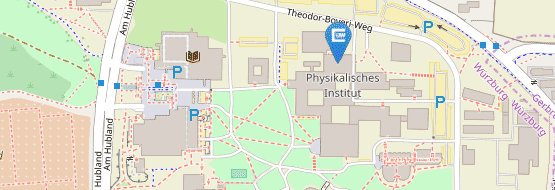i-RTG Lectures
"To see a world in a grain of sand, and the Universe in the electrons of solids"
| Date: | 11/21/2025, 10:00 AM - 12:00 PM |
| Category: | Kolloquium |
| Location: | Hubland Süd, Geb. P1 (Physik), Röntgen-HS |
| Organizer: | SFB 1170 ToCoTronics |
| Speaker: | Andrés F. Santander-Syro - Université Paris-Saclay & CNRS, Orsay, France |
Many interesting open problems of Physics, spanning all scales in the Universe, have one thing in common: they deal with systems composed of many strongly-interacting fermions. Think about the quarks confined inside a nucleon, or the nucleons in compact heavy nuclei, or the quarks in dense neutron stars. As it turns out, several classes of materials, some of them present in our daily life, display also strongly interacting electrons, sometimes in conjunction with boundary conditions confining the electrons in two or one dimensions. Such strong “electron correlations” give rise to a broad realm of phase transitions and exotic, often poorly understood, states of matter showing remarkable macroscopic properties, such as metal-to-insulator transitions, large magneto-resistance, or high-temperature superconductivity –as illustrated in the figure below, left panel, for a copper-oxide superconductor.
In the first part of this talk, I will introduce the general problem of strongly interacting fermions, and show how strong electron interactions arise in some types of materials. I will discuss the observed consequences of such behaviour, their possible relation to other problems in physics (e.g., the phase diagram of quarks, central panel in the figure), and their potential applications.
Subsequently, I will show how one can experimentally study the quantum-mechanical electronic states in such materials –i.e., how we can directly measure the eigen-energies of their Schrödinger equation, even if nobody knows yet how to calculate them. I will then discuss the application of such a technique to the case of an emblematic problem of modern Condensed Matter Physics, namely, the the Mott metal-to-insulator transition. In fact, in the “Standard Model of Condensed-Matter Physics”, metal or insulator are mutually exclusive states of matter. Thus, the very existence of a transition between both states is a fundamental phenomenon whose understanding has remained a challenge for over 50 years. Our measurements unveiled the “transmutation” of the wave-like itinerant electrons in the metallic state into localized-like particles in the insulating state, showing how increased electron correlations can fundamentally change the microscopic nature of a system.
Strongly correlated fermion systems. Left, generic phase diagram (temperature vs chemical potential of electrons) of a high-temperature copper-oxide superconductor, showing the observed antiferromagnetic (AF), pseudo-gap, spin-glass (SG), superconducting (SC), non-Fermi-liquid, and Fermi-liquid phases. Middle, hypothetical phase diagram (temperature vs chemical potential) of quarks, according to quantum chromo-dynamics (courtesy Andreas Ipp, TU-Wien). Right, experimental evolution of the electronic energies from metallic to insulating in a vanadium oxide sample (M. Thees et al., Science Advances 2022).


